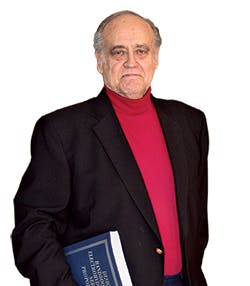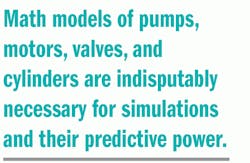Math Models for Hydraulics Coming to ISO
This file type includes high-resolution graphics and schematics when applicable.
A mathematical model is an equation or set of equations used to predict the behavior or performance of some machine at a specified set of conditions. Thus, when we say that the force (F) is calculated by multiplying a cylinder pressure (P) times its piston area, and its speed (v) is calculated by dividing the input flow by the cylinder area, we are in fact using the ideal math model of a cylinder.
We can use a computer to calculate the cylinder’s force and speed at any number of pressures, flows, and areas. In short, we program the computer so that it “thinks” it is the cylinder. This is a basic kind of simulation. Given the pressure and flow, we use the math model to predict the cylinder’s force and speed.
Important research is being conducted by colleges and universities around the world. The International Journal of Fluid Power (IJFP) reports three times annually on significant fluid power research results in graduate schools worldwide. In the U.S., work is being conducted by the Center for Compact and Efficient Fluid Power, a network of researchers, educators, students, and industry working together to advance the fluid power industry. Their efforts are reported in numerous technical conferences, and development of math models is a vital part of their work.
Math models of pumps, motors, valves, and cylinders are indisputably necessary for simulations and their predictive power. With good models and simulations, new and innovative application concepts can be studied before committing a single penny to hardware. Thus, we predict how the hardware will behave when we build a prototype.
Eventually, though, we won’t need to build a prototype. Digital electronic models and simulations are so reliable that an electronics engineer can design and thoroughly debug a logic circuit with available software tools. The design goes from concept to simulation to electronic chip foundry without the need for a prototype.
In the end, modeling and simulation must converge on the hardware—not just prediction. Design methodology will increasingly use an analytical highway that is paved with an innovative, yet practical, set of new first principles using ever more powerful computers. That pathway will be smoothed by the faculties of colleges and universities equipped to teach standardized math models and simulations. The design processes can occur in a fraction of the time needed for time-consuming trial-and-error methods. The latter is the old-fashioned way, which we can no longer afford.
Standardized math models are now on the agenda of the Testing Subcommittee of ISO’s TC-131 (ISO/TC-131/SC-8). A set of internationally accepted and standardized math models must be the first step in preparing this new set of first principles.
Toward that end, Dr. Jose Garcia of Purdue University, Paul Michael of MSOE, John Montague (retired from Bosch Rexroth), and I have put together a new proposal for the international standardization of math models for hydraulic pumps, and it is on the agenda for the next round of ISO meetings in San Antonio this May.
Please e-mail at [email protected] me if you are interested in participating or would like more information.





